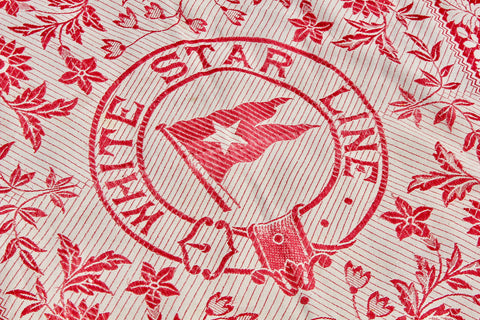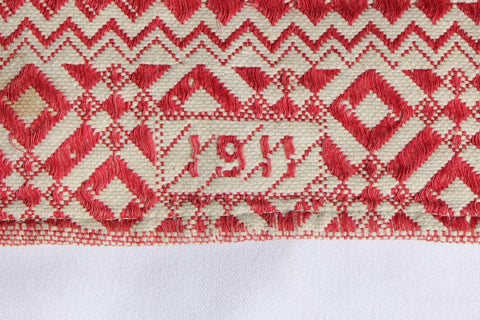White Star line was a shipping company whose reputation was built on comfort over speed or innovation. If a transatlantic crossing was going to take seven or eight days, the company felt those days should be spent in the utmost luxury, all three classes on the Olympic & Titanic boasted unsurpassed facilities over the majority of their competition crossing the Atlantic.
One area the company excelled in was the quality of its ships soft furnishings, form the expensive rugs, the novelty of fitted carpets, silk drapes in staterooms to the most humble bed covers found in the lowest class, quality was always paramount.
On the Olympic class liners, the beds found in the suites and First Class staterooms boasted fine white damask covers over the sheets. Woven into the designs, which reflected the decadence of the guided era, the full company garter logo of the White Star Line. The covers are a feast of proud five pointed stars, executed in an empire style which matched some of the ships suites and interior detailing.


The empire theme was featured on both Olympic & Titanic in the ships suites and staterooms, the damask covers matched the sumptuous interiors they were chosen for.

These same style and design of damask covers could also be found within the staterooms of the 2nd Class.
This design and similar in damask was in use from the entry into service of the Olympic right up until the early 1930's. Often the sheets have a date or registration number hidden within them to indicate to crew how old the sheets were, with the idea of being replaced if needed to keep the service fresh. After all, although of outstanding quality by todays standards they not only had to endure service of what in effect was a hotel at sea but also the heavy industrial machines used for washing them if not done by hand when the laundry that was not done on the ship was landed at Southampton and taken to the various laundry's that survived from the ships using the port. The fact any survive to this day is no mean feat.
As already mentioned, the level of quality for each respective class onboard the ship was the highest of quality, and for passengers traveling by the lowest class, Third, the quality could be argued to be unsurpassed on the Atlantic. Covers were designed, again capturing the epitome of the gilded era, in a loose late victorian pre cursor to the Art Nouveau style. The design would change little being used or seen in publicity material from the early 1900's White Star Line ships through to the 1930's, similar designs still being used on the Queen Mary in 1936. Although not as refined as the damask covers found in the First & Second Class, the material was a hardy but comfortable cotton that again would withstand the rigours of life at sea in a floating hotel, hand washing or later industrial washing machines.

A particularly fine example of a 3rd Class blanket, in exceptional condition and a rarely seen design, dated c-1911, and almost certainly intended for the RMS 'Olympic', identical examples would have been used and ordered on RMS 'Titanic'.



Two differing types of 3rd class blankets, the top example dated c-1911, and likely ordered for the Olympic, identical examples would have been produced for Titanic. The lower example, of a similar date through to the early 1920's.

A Third Class cabin from a White Star Line promotional brochure, c-1911, showing similar covers in situ.


A similar 3rd Class blanket as pictured in the original White Star Line advertising brochure, this time minus a flag of central star. There was at least three designs for these blankets, in use from their introduction around 1911 until the company merger with Cunard in 1934, when a similar design in both red & blue was used featuring the new combined company name only without logo. This example has a date cade woven into the design in this case for c-1920.
Also to take into consideration are the blankets used within standard 1st and 2nd Class staterooms from the late teen until the early 1930's. These were under blankets to keep passengers warm on cold transatlantic crossings. Usually relatively plain in nature they simply display the initials of the company, in the case of those below, 'W.S.L.' for White Star Line, and the rarely seen earlier example, 'O.S.N.Co' for the Oceanic Steam Navigation Company. Due to there utilitarian nature these blankets would find second lives after being sold off by the shipping companies in private homes and hotels on land. As a result very few survive from over use or moth damage. These examples come direct from the family of Thomas Ward & Son and purchased directly from the Olympic herself.

White Star Line 1st or 2nd Class stateroom under blanket, c-1920, ex- RMS 'Olympic'.


Oceanic Steam Navigation Company 1st or 2nd Class stateroom under blanket, ex-RMS 'Olympic'.
And finally we cannot forget the blankets that were used up on deck. There are few images that conjure up a more idyllic vignette than being wrapped up in a tartan blanket, nested on a deck chair on the decks of a speeding ocean liner, looking out at the great vastness of the passing North Atlantic ocean. It was a right of passage for transatlantic passengers to be wrapped up by the deck steward, enjoy the view and be served tea, coffee or beef bouillon.
White Star Line unsurprisingly had a hierarchy in its deck chair or 'steamer rugs', to First & Second Class. First Class examples were in effect two blankets in one, being double layered to keep its premium passenger warm from the chill of the passing atlantic air. Second Class examples, although still 100% pure lambs wool of the finest quality was a mere single layer. The logo used upon these blankets was also somewhat less elaborate than its First Class counterparts, bearing the companies initials only, but still finely hand stitched in a typical early edwardian typeface, 'W.S.L.'. Today few of the Second Class examples survive in good order.


A selection of steamer rugs used on the White Star Line, and similar to those used upon the RMS 'Titanic' & 'Olympic'. Those shown above are for, 1. First Class. 2 & 3 Second Class. Those for use in First Class are double layer wool, their counterparts in Second Class only a single layer. Its probable that those shown as used in Second Class were probably also used within Third Class too.
A practise that is still observed today onboard the last true liner crossing the atlantic, the QM2. Great pride was placed in getting the best spot on deck. You could request and reserve a seat for an entire crossing, but savvy frequent passengers would strike up friendships with the stewards to secure the best or prized positions on earlier sailings. Great sums of money were exchanged in the management of deck chairs and deck chair blankets.

An illustration from a White Star Line publicity brochure from around 1911, showing passengers sporting very similar tartan designed blankets on the 2nd Class deck of an Olympic class liner. Similar scenes would have undoubtedly occurred onboard the Titanic on the days leading to her sinking.

An original White Star Line tartan blanket, c-early 1920's, very similar to an example that survived the sinking of the Titanic that was sold in auction in the late 1990's.
Titanic survivor Charlotte Collyer and her young daughter, escaping the sinking liner had one of these same First or Second Class blankets wrapped around her by a sailor to keep her warm whilst in the lifeboat and kept as a souvenir of that ill fated night, April 1912. She can be seen still clutching it as a painful reminder of that harrowing night in contemporary press pictures taken after the sinking after recounting her story to the press.

Titanic survivor Charlotte Collyer and her young daughter in a contemporary press photo, still clutching the blanket that had kept her and her daughter warm whilst awaiting rescue from the Carpathia.
These blankets were made of the best 100% full wool, with hand embroidered company logos to the lower corner. Originally most would have had one or two brass 'eyes' in the lower corners, to allow the deck steward to wrap the blanket around the base of the foot stool of the deck chair and secure it, and keep the passenger nice and warm. Few of these in good order survive to this day, most have succumb to the horrors of moth damage after being relegated to a cupboard, loft or shed, examples in unaltered or unfaded condition are rare.
Similar navy blue & red wool examples with a hand embroidered company name for Cunard were still in constant use on the QE2 all the way until 2008, plain blankets in a similar pattern are still issued to Grill passengers on the QM2.
The Pursers Locker are very pleased to have sourced these three beautiful and rare articles of ocean liner history .



Comments (0)
Back to News